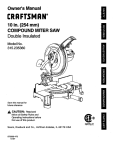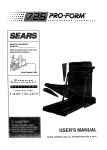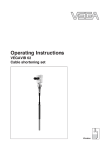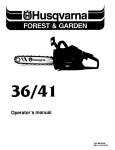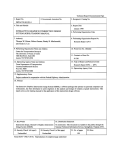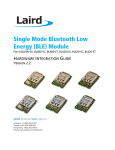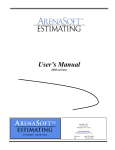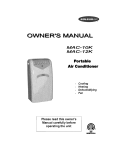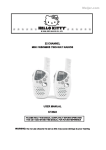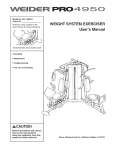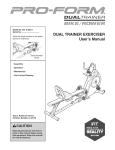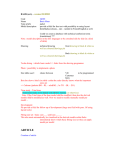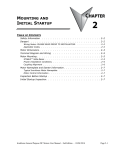Download Interactive Graphics Intersection Design System
Transcript
Technical Report Documentation Page 1. Report No. 2. Government Accession No. 3. Recipient's Catalog No. FHWAffX-98/1291-2 4. Title and Subtitle 5. Report Date January 1998 INTERACTIVE GRAPHICS INTERSECTION DESIGN SYSTEM (IGIDS): RESEARCH REPORT 7. Author(s) 6. Performing Organization Code 8. Performing Organization Report No. Thomas W. Rioux, Robert Inman, Randy B. Machemehl, and Clyde E. Lee 9. Performing Organization Name and Address Research Report 1291-2 10. Work Unit No. (TRAIS) Center for Transportation Research The University of Texas at Austin 3208 Red River, Suite 200 Austin, TX 78705-2650 11. Contract or Grant No. 0-1291 13. Type of Report and Period Covered 12. Sponsoring Agency Name and Address Texas Department of Transportation Construction/Research Section P.O. Box 5080 Austin, TX 78763-5080 FAgoncyCode Research Report (9/96 - 8/97) 15. Supplementary Notes Project conducted in cooperation with the Federal Highway Administration. 16. Abstract The Interactive Graphics Intersection Design System (lGIDS), a software package that operates on personal computers and workstations, has been developed to assist engineers in the analysis and design of isolated, at-grade intersections. In addition to documenting the development of this program, this report describes the new features incorporated into the IGIDS package. 17. KeyWords 18. Distribution Statement Intersection design, Interactive Graphics Intersection Design System (lGIDS) 19. Security Classif. (of report) Unclassified No restrictions. This document is available to the public through the National Technical Information Service, Springfield, Virginia 22161. 20. Security Classif. (of this page) Unclassified Form DOT F 1700.7 (8-72) Reproduction of completed page authorized 21. No. of pages 56 22. Price INTERACTIVE GRAPHICS INTERSECTION DESIGN SYSTEM (IGIDS): RESEARCH REPORT by Thomas W. Rioux Robert F. Inman Randy B. Machemehl and Clyde E. Lee Research Report Number 1291-2 Research Project 0-1291 Interactive Graphics Intersection Design System (IGIDS) Conducted for the TEXAS DEPARTMENT OF TRANSPORTATION in cooperation with the U. S. Department of Transportation Federal Highway Administration by the CENTER FOR TRANSPORTATION RESEARCH Bureau of Engineering Research THE UNIVERSITY OF TEXAS AT AUSTIN January 1998 ii This report was prepared in cooperation with the Texas Department of Transportation and the U.S. Department of Transportation, Federal Highway Administration. ACKNOWLEDGMENTS The authors express appreciation for the guidance provided by the TxDOT Project Director, H. Wickes (TRF), and by the Project Monitoring Committee, which included J. Barron (Waco), M. Emery (Tyler), B. Gilley (Lubbock), J. Kelly (Lubbock), C. Slacum (Lufkin), and E. Sanchez (El Paso). DISCLAIMERS The contents of this report reflect the views of the authors, who are responsible for the facts and the accuracy of the data presented herein. The contents do not necessarily reflect the official views or policies of the Federal Highway Administration or the Texas Department of Transportation. This report does not constitute a standard, specification, or regulation. There was no invention or discovery conceived or first actually reduced to practice in the course of or under this contract, including any art, method, process, machine, manufacture, design or composition of matter, or any new and useful improvement thereof, or any variety of plant, which is or may be patentable under the patent laws of the United States of America or any foreign country. NOT INTENDED FOR CONSTRUCTION, BIDDING, OR PERMIT PURPOSES Randy B. Machemehl, P.E. (Texas No. 41921) Research Supervisor iii iv TABLE OF CONTENTS CHAPTER 1. INTRODUCTION ....................................................................................... 1 Research Problem Statement ................................................................................... 1 Background ............................................................................................................. 1 Caution .................................................................................................................. 15 Objectives .............................................................................................................. 15 Implementation...................................................................................................... 16 Benefits .................................................................................................................. 16 CHAPTER 2. IGIDS ......................................................................................................... 17 Metrication ............................................................................................................ 17 Vertical-Alignment-Based Sight Distance Checking ............................................ 17 Traffic Control Device Placement......................................................................... 27 Training ................................................................................................................. 27 Highway Capacity Manual Chapter 9 Analysis .................................................... 28 Other Features ....................................................................................................... 29 REFERENCES .................................................................................................................. 33 APPENDIX ....................................................................................................................... 37 v vi CHAPTER 1. INTRODUCTION RESEARCH PROBLEM STATEMENT The recently completed Research Study 0-1308, Interactive Graphics ll;ltersection Design System (IGIDS) (Ref 2), has produced computer-aided design software for intersection design, redesign, and modification. At the April13, 1994, presentation of these research results to the Area 3 Committee, members requested at least two additional features be provided. These features included the following requests: (1) supplement the already provided sight distance checks based on horizontal alignment with vertical-alignment-based sight distance checking; and (2) allow the designer to easily place signs, pavement markings, and signalization layout features into a graphics file that can be plotted from IGIDS or the Texas Department of Transportation (TxDOT) Automated Plan Preparation System (APP) and automatically generate a current bill-of-materials file as traffic control features are placed. The IGIDS software has been designed to operate on a variety of hardware platforms, including workstations and personal computers. The graphics-based primary and utility functions provided through the software are, therefore, technically available to most individuals having computing hardware access. However, many potential users only fully employ IGIDS if user training is provided. Such training should be developed and offered as soon as possible. BACKGROUND The research team and the TxDOT Departmental Project Director (PD) have recently completed the initial version of the Interactive Graphics Intersection Design System (IGIDS). The IGIDS software has been designed to facilitate extension and expansion. Throughout the development process, significant effort has been devoted to designing and implementing an intricate foundation for an evolving, fully featured IGIDS. The system that has evolved operates upon this foundation; that is, it has been carefully configured to permit the addition of capabilities that will ultimately make the IGIDS an extremely efficient and valuable engineering tooL The IGIDS conceptual background is included here for the sake of completeness. The previous TxDOT research projects that developed IGIDS at the Center for Transportation Research at The University of Texas at Austin included the following: (1) Project 0-1139 (Ref 1), conducted from September of 1988 to September of 1991. This project undertook the initial design and development of IGIDS using MicroStation Clix Version 4 (Refs 4-6) (Unix only) and the C programming language. (2) Project 0-1308 (Ref 2), conducted from September 1991 to September 1993. This effort incorporated additional features using MicroStation Clix Version 4 (Refs 46) (Unix only) and the C programming language. 1 (3) Project 0-1308 extension (Ref 2), conducted from September 1993 to September 1994. This project converted IGIDS to MicroStation DOS Version 4 (Refs 4-6) using the MicroStation Development Language (MDL) programming language (Ref7). (4) Current Project 0-1291 (Ref 3), conducted from September of 1995 to September of 1997. This project added vertical sight distance checking, striping, and traffic inventory reporting. It also developed training material using MicroStation 5 (Refs 8-10) and MicroStation 95 (Refs 13-15) and the MicroStation Development Language (MDL) programming language (Refs 11-12). Over the past two decades, a number of computer-aided engineering and design tools, such as the Roadway Design System (RDS), have been developed to handle an everincreasing share of the computational and graphical work required for highway design. Such tools offer the potential for significant improvement in engineering efficiency and effectiveness. Among other things, these aids relieve engineers of the burden of computing coordinate geometry, permit visual imaging of proposed geometry, and aid significantly in the timely preparation and revision of plans and specifications. As computer-aided design and drafting tools are upgraded and extended to deal with both routine and complex design tasks, engineering talent can be applied to optimizing designs rather than to the more timeconsuming computing and drafting tasks. Although many aspects of highway design are currently handled by RDS, much of the detailed effort required for analyzing, designing, and modifying at-grade intersections is not included. The technology that has been developed through the evolution of RDS, particularly that associated with interactive graphics, is now available for application in the design and modification of at-grade intersections. Intersection design involves not only the geometric, structural, and drainage features of the roadway that are now handled by RDS, but also the many traffic operational aspects. Before a set of plans can be fmalized, detailed analyses must be made concerning capacity, level of service, delay, channelization, type of traffic control devices, physical siting of traffic control devices, safe approach speeds, emissions, fuel consumption, and other factors. While various computer aids designed to assist in evaluating these factors have already been developed, others are still needed. These aids need to be consolidated into a package that can allow easy access by an engineer through a desktop, interactive-graphics workstation. The capability of the desktop workstation has now reached a level such that many intersection analysis and design tasks can be performed quite efficiently by engineers equipped with appropriate software and relatively inexpensive computer hardware. Communications technology is also available to permit reliable, low-cost transfer of design files from micro to micro and to mainframe computers when design tasks dictate the need for more extensive computing power. 2 It is also feasible to develop computer software that permits interactive graphical presentation of all-important aspects of at-grade intersection design on a variety of computer hardware configurations. Interchangeability of software components and design files among these hardware systems will provide a very flexible and efficient working environment for engineers involved in intersection design and modification. Intersection design is a complex process that involves many different skills. Elements of transportation planning, traffic engineering, and geometric design contribute to the process of designing the most practicable facility for handling intersection traffic. Traditionally, the design engineer has relied on the application of manual, or sometimes computer-aided, procedures to determine the most appropriate alternative that satisfies the objectives. The process involves geometric layout; traffic analysis; channelization, selection, and placement of traffic control devices; timing of traffic signals; lighting; drainage; fuel-consumption evaluation; pollution analysis; cost estimating; and other engineering functions which are eventually reduced to practice in a set of plans and specifications. Virtually all the engineering and analysis procedures needed to complete the design process are well known and documented. IGIDS assists engineers in the analysis and design of isolated, at-grade intersections and operates on personal computers and workstations. The role of IGIDS is to provide the intersection design engineer with suitable tools to assist with each process stage. These tools may be loosely divided into three groups. The first group includes the drawing tools. IGIDS uses MicroStation as a graphics engine to perform all graphics input and output. The user may select from an IGIDS library one of several typical intersection designs and then modify it as needed to define the particular intersection of interest. Alternately, the user may define the intersection geometry by pointing at selected elements in a reference file created by another source, such as a topographical map of the area (with optional use of a superimposed aerial photo). Finally, the user may create the key components of the intersection geometry on the scratch level using MicroStation commands (with optional use of a superimposed aerial photo) and then define the intersection geometry by pointing at these elements. Mter the intersection leg centerlines have been defined, IGIDS provides several commands by which to place lanes and curb returns and to manipulate the various intersection elements. The elements of the design may be specified by the most convenient method for the particular situation. For example, lane width may sometimes be specified by keyboard entry of a numerical value. Or, it may be more convenient to identify lane edge graphics in a file that is being viewed concurrently with the IGIDS graphics file. Alternately, requesting that the lane edges be located by identifying existing landmarks on a superimposed aerial photo may be most convenient. Such traffic control features as stop signs, yield signs, signal controller cabinets, channelization symbols, and signal heads may be placed by the user. Traffic data may be entered as tum-movement volumes or as leg volumes with turn percentages using a dialog box. Signal phasing is entered graphically, while signal timing is entered via a dialog box. 3 Centerline, lane, edge, and stop line striping may be added using other IGIDS elements. Additional striping for islands, tapers, and gores may be created using graphical elements placed at the scratch level. Striping types include solid line, broken line, dotted line, lane drop, no-passing inbound, no-passing outbound, double solid line, and double broken line. Striping widths are 100, 150, 200, 300, 450, and 600 mm (4, 6, 8, 12, 18, and 24 inches). Striping colors are white and yellow. Only valid combinations of striping type, striping width, and striping color can be placed by the user. Next are the built-in analysis tools. Both graphical aids and computational analysis procedures are incorporated. For standard AASHTO design vehicles, vehicle-turning templates (Ref 31) may be quicldy drawn to a user-specified turn radius for the turn between adjacent, user-selected legs. These templates may be moved dynamically over the intersection geometry to evaluate pavement edge and channelization requirements. For checking horizontal sight distance restrictions, sight lines for stopped vehicles, yielding vehicles, or vehicles approaching an uncontrolled intersection may be drawn. For vertical sight obstruction checking within the horizontal sight distance triangle, the triangle me created from a Digital Terrain Model (DTM) must be attached as a reference file and the user must be in a 3D MicroStation design file. Procedures described in the 1994 Highway Capacity Manual Special Report 209 (Ref 30), Chapter 9, "Signalized Intersections," may be used to identify v/c ratios and delays for intersections with pretimed controllers. IGIDS displays the v/c ratios and delays in bar chart format for each leg. An inventory or bill-ofmaterials for traffic control features can be requested in printed or spreadsheet-compatible input file format. Finally, there are data-manipulation tools that can be used to prepare data files for analyses that are executed outside IGIDS, with the results then brought back into IGIDS. The TEXAS Model for Intersection Traffic (TEXAS Model) (Refs 16-23), the Signal Operations Analysis Package (SOAP) (Refs 24-26), and the TxDOT Automated Plan Preparation System are supported by IGIDS. The TEXAS Model provides microscopic simulation of vehicular traffic flow through a single intersection or a diamond interchange and generates both a statistical summary and animated graphics that show drawn-to-scale, color-coded vehicle types moving through the intersection geometry. Selected TEXAS Model statistics may be displayed in bar-chart format for each leg and for all intersection legs. SOAP develops and assesses isolated intersection signal timing plans. Data for both the built-in and external analyses are drawn from a common .database maintained by IGIDS. Many of these data are extracted from the graphical intersection geometry defined by the user. Some nongraphical data, such as traffic volumes, must be keyed in. IGIDS is a MicroStation MDL application. MicroStation is a computer-aided drafting (CAD) software package developed by Bentley Systems, Inc., and is the CAD standard currently implemented by the Texas Department of Transportation (TxDOT). The user must have a working version of MicroStation to run IGIDS. IGIDS is available for 4 MicroStation Version 4.0 for DOS/Windows and Clix; for MicroStation Version 5 for DOS/Windows, Windows 95/Windows NT, and Clix; and for MicroStation 95 for DOS/Windows and Windows 95/Windows NT. IGIDS data may be in English or metric units, though once a project has been started in a given measurement system, the system of units may not be changed. While IGIDS may be operated using a 2-D MicroStation design file, a 3-D file is required for vertical sight obstruction checking within the horizontal sight distance triangle. To change the file format from 2D to 3D, the user may save the IGIDS project to a database file, enter a 3D file, and then load the project from the database file. IGIDS is now available from The University of Texas at Austin's Civil Engineering Department's anonymous ftp site and will be made available by McTrans (Ref 33) in the future. The ftp site can be accessed by an Internet browser at ftp://ftp.ce.utexas.edu/ftp/igids or by the ftp program at ftp.ce.utexas.edu, with the igids directory then selected. The igids directory contains documentation, dos, and winnt sub-directories. The DOS directory contains ustn40, ustn50, and ustn95 sub-directories. The winnt directory contains ustn50 and ustn95 subdirectories. IGIDS uses a graphics engine (MicroStation) to perform all interactive graphics operations and to maintain the graphics engine database. IGIDS software operates above and drives the graphics engine through a higher-level language interface. IGIDS allows the user to switch easily between executing IGIDS commands and graphics engine commands. The commands available within the graphics engine are used for this purpose as much as possible. IGIDS does not provide plotting capabilities, but relies upon the graphics engine to perform such operations. IGIDS accommodates up to fifteen alternative designs for an intersection. Existing intersection conditions will normally constitute one alternative. Each alternative, and its major graphical component groupings, is placed on separate graphical levels, or planes, so that it can be displayed independently, or not displayed in a particular view, by the graphics engine. IGIDS allocates a user graphical level, or plane, and allocates a scratch graphical level, or plane. All, or part, of an intersection alternative can be copied to another alternative, and all, or part, of an intersection alternative can be modified by IGIDS commands. In addition, any number of reference files may be attached to the master design file by the graphics engine. IGIDS can locate elements in these reference files to be added as graphics for IGIDS. Finally, the graphics engine may display a raster image, a scanned photograph, or other raster data. IGIDS graphics will normally be two-dimensional in plan view and will use a state plane coordinate system operating in either English or metric units. Coordinates, distances, and other real numeric data are stored as 16 significant digit, 64-bit, double precision, floating-point variables in the master units of the graphics engine (feet or meters). All angular data will be stored as the same type variables, but in degrees. All counter or indexing-type, numbers will be stored as 10 significant digit, 32-bit, integer variables. All 5 other integer numbers with no perceived possibility of exceeding several hundred will be stored as 5 significant digit, 16-bit, integer variables. IGIDS uses relational hierarchical geometry. Relational geometry refers to the fact that the only absolute coordinate needed by IGIDS is the center of the intersection. The legs of the intersection are defined relative to the intersection center; the lanes of a leg are then defined relative to the leg's centerline and so on. IGIDS data are stored as objects, with IGIDS maintaining the parent-child relationships among IGIDS objects. IGIDS works by manipulating a defined set of objects. There is a strict set of rules used by IGIDS that fixes the way that these IGIDS objects are related to each other. The task of complying with these rules is assigned to IGIDS, so the user need not be concerned with the relationship details. IGIDS defines the relative object for each type of IGIDS object. IGIDS calculates the station and offset of a coordinate from the leg centerline for all items that are a child of the leg. Only IGIDS commands can be used to manipulate the geometry, because of the need to update the data in the IGIDS structures. IGIDS minimizes requirements that the user enter data in a defined order or sequence. To accomplish this objective, IGIDS will automatically sort each list of children IGIDS objects as new children IGIDS objects are added to the list so that the user can enter geometry data items in any order. IGIDS automatically sets the direction of any entered graphical IGIDS object so that it will conform to the sorted direction of the list of which it is a part. Hierarchical geometry refers to the fact that the IGIDS objects are related in a parentchild relationship. Each IGIDS object will comprise only one parent IGIDS object and may have zero or more children IGIDS objects. An IGIDS object can have different parent IGIDS object types, with the type of parent being associated with the attributes of an IGIDS object. Each IGIDS object knows the type of its parent IGIDS object and which specific IGIDS object entry is its parent. An IGIDS object can have more than one category of child IGIDS object. The number of children IGIDS objects accommodated by IGIDS is virtually infinite. Each parent IGIDS object maintains the current number of children IGIDS objects and has a pointer to the beginning and ending children IGIDS objects for each category of children IGIDS objects. Each IGIDS object has a pointer to the previous and to the next IGIDS object on the list. An IGIDS object with a null previous pointer is the first IGIDS object on the list. An IGIDS object with a null next pointer is the last IGIDS object on the list. An IGIDS object with a null previous pointer and a null next pointer is the only IGIDS object on the list. Most high-level IGIDS objects serve to group the children IGIDS objects and only the lowest-level IGIDS objects have a graphical representation. Any procedure applied to an IGIDS object is automatically applied to all the children of the IGIDS object. The six IGIDS objects are Intersection, Alternative, Leg, Lane, Seg (Segment), and Text. There is only one intersection IGIDS object and it has a list of up to fifteen alternatives and other intersection data. Each alternative IGIDS object has an intersection parent pointer, a list of legs, a list of text, and other alternative data. Each leg IGIDS object has an alternative parent pointer, a list of centerline segments, a list of inbound lanes, a list of 6 outbound lanes, a list of inner edge curb return segments, a list of outer edge curb return segments, and other leg data. Each lane IGIDS object has a leg parent pointer, a list of inner edge segments, a list of outer edge segments, a list of stop line segments, a list of inner edge striping segments, a list of outer edge striping segments, a list of stop line striping segments, a list of other striping segments, and other lane data. Each segment IGIDS object has a leg/lane parent pointer, a list of texts, and data for either an arc of a circle or a line. Each text IGIDS object has an alternative/segment parent pointer and text data. Each IGIDS object may have either a parent or child relationship with other different-type IGIDS objects. Any IGIDS object may have only one parent, but a parent may have none, one, or more children. Only Segs and Text have displayable graphic elements. All others have graphical visibility owing solely to the attached child IGIDS objects. Each IGIDS object may have a virtually unlimited number of children. The one exception to this is the number of Alternatives is limited to fifteen. There is always only one Intersection. The leg centerline must be entered and completed before any lanes may be attached. An IGIDS command applied to an IGIDS object is automatically applied by IGIDS to all child IGIDS objects of the selected IGIDS object. It is convenient to subclassify some IGIDS object types. The IGIDS object type Text is seen to have more than one possible type of parent. When each Text is created, it will be subclassified to be either Text on a Seg or Text on an Alternative. This designation will remain unchanged for the life of the Text. Both Lane and Seg are seen also to have subclassifications. A Lane is either an Inbound Lane or an Outbound Lane. A Seg is a Lane Inner Edge Seg, Lane Outer Edge Seg, Lane Stop Line Seg, Lane Inner Edge Striping Seg, Lane Outer Edge Striping Seg, Lane Stop Line Striping Seg, Lane Other Striping Seg, Leg Centerline Seg, Curb Return Inner Edge Seg, or Curb Return Outer Edge Seg. Note also that Segs may have either Lane or Leg parents. Intersection - Alternative Leg Intersection - Alternative Leg Alternative Intersection Alternative - Leg Intersection Alternative - Leg - Inbound Intersection Intersection Alternative - Leg Inbound Intersection Alternative - Leg - Inbound Alternative Leg - Inbound Intersection Leg - Inbound Alternative Intersection Alternative - Leg - Inbound Intersection Intersection Alternative - Leg - Inbound Intersection Alternative - Leg - Outbound Intersection Alternative - Leg - Outbound Alternative - Leg - Outbound Intersection Intersection Alternative - Leg - Outbound Intersection Alternative - Leg - Outbound Intersection Alternative - Leg - Outbound Intersection Alternative - Leg - OUtbound - - Lane Lane Lane Lane Lane Lane Lane Lane Lane Lane Lane Lane Lane Lane - - Centerline Inner Edge Curb Return Outer Edge Curb Return Inner Edge Outer Edge Stop Line Inner Edge Striping Outer Edge Striping Stop Line Striping Other Striping Inner Edge Outer Edge Stop Line Inner Edge Striping Outer Edge Striping Stop Line Striping Other Striping IGIDS Object Relationships 7 Seg Seg Seg Seg Seg Seg Seg Seg Seg Seg Seg Seg Seg Seg Seg Seg Seg - Text Text Text - Text - Text - Text - Text - Text - Text - Text - Text - Text - Text - Text - Text - Text - Text - Text Stondord 414 Stondord 414 IGIOS AI tern<:>tl ve IGIDS Alternative 8 Slcnbd 414 I I II II II II II II ~ lr-1 I II II II II II Slcnbd 414 II IGIDS Text on AI ternatl ve IGIDS Text on Alternative 9 4X4 I II I II II II IGIDS Leg I ~r·-·-·-·~------------------~ / !GIDS Leg IGIDS Leg (enlarged) 10 IGIDS Leg Center hne IGIDS Leg Centerline )== ---1--------l--1,\ ' / : "--c------------~- - - - -~+----------, ' / IGIDS Inbound Lane IGIDS Inbound Lane ' ---+-------T-------------1 IGIDS Inner Edge Segment 11 f---'----1.....1 _j \ I"' __________ ] ~L_ __ / IGIOS Outer Edge Segment IGIDS Outer Edge Segment / . ··~·~- t - - - - - - - - - - - - - - - IGIOS Stop Lme Segment IGIDS Stop Line Segment 12 I 1-------- I I I \ I I I / f-f-- I ' ·------------ -------+------- f-- I I I 1- "' \ I / ---------------IGIDS Outer Edge Curb Return Segment I I I I IGIDS Outer Edge Curb Return Segment 13 IGIDS automatically sorts an alternative's list of legs, a leg's list of inbound lanes, a leg's list of outbound lanes, and each list of segments. This automatic sorting allows the user to enter elements in any order. An alternative is considered completed when all of its legs are completed. A leg is considered completed when all of its centerlines, inbound lanes, outbound lanes, inner edge curb returns, and outer edge curb returns are completed. A lane is considered completed when all of its inner edges, outer edges, stop lines, inner edge stripings, outer edge stripings, and stop line stripings are completed. A list of segments is considered completed when ( 1) no segments are entered for optional elements like curb returns and striping, (2) one segment is entered, or (3) two or more segments are entered and there is no geometric gap between adjacent segments. IGIDS maintains the design as descriptive data stored in the host computer's memory. This stored data are a complete record of the Intersection design. Included are the attributes of each IGIDS object and how IGIDS objects are related, data that have been calculated during the design process, and data that have been entered manually by the user. The data may be stored as a disk file and later retrieved. The IGIDS database will be the master database. All graphics and attribute data items will be contained in the IGIDS database, and the value stored there will have precedence over any other value. Thus, the graphics engine database can be deleted or all of the graphics in the graphics engine database can be deleted or erased and IGIDS will be able to re-create the graphics previously saved into an IGIDS database using the LOAD FROM->DATABASE command. Any graphics added by the user on the scratch level will be lost. Any IGIDS vehicle tum template, sight distance checking, TEXAS Model statistics, and Highway Capacity Manual Chapter 9, graphics will be lost but are easily re-created from the IGIDS database information. Coordinate, distance, angular, and other data in the IGIDS database will be considered the definitive values. IGIDS will always use the values in the IGIDS database for all calculations. IGIDS will keep the entire IGIDS database in memory so that no disk I/0 will be involved in reading a data item; this will allow the software to operate as fast as possible. IGIDS presents this design to the user as graphics displayed by the graphics engine. The ID of each IGIDS object that is displayed (segs and text) is a part of the graphics engine's data and is used to link the graphics engine database with the IGIDS database. Each IGIDS graphical item in the graphics engine database will contain the ID of the corresponding item in the appropriate IGIDS structure where the attribute data will be stored. The type of the graphics engine element (arc, line, or text) will be used to determine the item type (segment or text) and, therefore, relate it to the appropriate IGIDS structure. The ID will identify the entry number, the instance number, or the row number in the appropriate IGIDS structure. Given an ID, IGIDS can search the graphics engine database or access the appropriate IGIDS structure for the specified item. The higher-level (grouping) objects may not have a graphical representation. During the design process, the user may interact with IGIDS to modify the design as desired. This interaction is through the graphics engine's user interface. The user may 14 identify existing graphical elements, specify geometric points, and key in alphanumeric data, all in response to IGIDS prompts. All usual graphics engine functions are always available. Graphics engine and IGIDS functions may be used in any desired sequence. If there is a need to construct a feature that is beyond IGIDS's capability, the graphics engine's tools may be used to create the feature as "scratch" graphics. IGIDS can then inspect these scratch graphics and add the desired feature to the design. Graphics on an existing drawing may be processed in a similar manner. Intersection analysis and design software packages will be executed when the user selects from a menu the software package. IGIDS will check its database for the appropriate data and prompt the user for any missing data. IGIDS will then extract data from the IGIDS database and build the required input files for the software package that was selected. The software package will be executed by the operating system as an external or background process, and the user may use graphics engine commands to review the output. When appropriate, the software package output will be displayed by IGIDS. CAUTION IGIDS takes control of the active graphics file and deletes everything except what is recognized as scratch graphics (all graphics on levels 3 through 62 are controlled by IGIDS, while level 2 is the scratch level). IGIDS presents to the user an Alert Box. Pressing the "OK" push button will allow IGIDS to continue, whereas pressing the "Cancel" push button will cause IGIDS to exit without deleting any data. IGIDS recreates graphics using IGIDS data rather than relying on stored graphics files. Therefore, at start-up, any graphics stored in the active file will be deleted. The IGIDS design is created by user interaction or by the importation of a previously created design that is stored in a database file. All needed graphics are drawn as a part of this process. Existing noniGIDS graphics should be accessed as a reference file. Reference files should be attached so that their elements can be snappedto and located. Upon ending IGIDS or ending MicroStation, IGIDS determines whether any data have been modified since any LOAD FROM->DATABASE command or the last SAVE TO->DATABASE command; if modifications have been made, IGIDS presents an Alert Box. Pressing the "OK" push button will allow IGIDS to perform a SAVE TO>DATABASE command, whereas pressing the "Cancel" push button will cause IGIDS to exit without saving any data. OBJECTIVES The primary objectives of Research Project 0-1291 were to provide (1) two additional functional features to the Interactive Graphics Intersection Design System (IGIDS), and (2) appropriate training resources that will acquaint potential users with IGIDS and its capabilities. Explicit objectives were the following: 1. Add a feature to IGIDS that will permit vertical-alignment-based sight distance checking. 15 2. Add to IGIDS a capability allowing users to graphically place signs, signals, and pavement markings which are captured into a graphics file that can be plotted from IGIDS or from TxDOT' s Automated Plan Preparation System (APP). 3. Generate a current bill-of-materials file as traffic control features are graphically placed by a user. 4. Develop concepts and materials for IGIDS-user training course(s). IMPLEMENTATION Results of this project can be put into immediate use by the Texas Department of Transportation (TxDOT) personnel who perform intersection design and improvement tasks. The IGIDS may be utilized by both division and district personnel of the Department, as well as by engineers in other governmental agencies. Although the IGIDS is not a substitute for sound engineering analysis and judgment, it provides engineers with powerful computational and graphical tools that can be used to develop and evaluate feasible alternative solutions to intersection traffic problems and thereby make sound engineering decisions. BENEFITS Effectiveness and efficiency of intersection geometry, traffic control, signage, and channelization are of growing importance to all traffic-engineering agencies within the state of Texas. User costs, such as delay and fuel consumption, and auto emissions, are directly related to intersection operations. The additional IGIDS features developed in this research project can help ensure appropriateness and efficiency of intersection design and improvement programs. The IGIDS training resources resulting from the research will help potential users of the software learn of its capabilities and how to best employ IGIDS features. 16 CHAPTER 2. IGIDS DEVELOPMENT METRICATION The first task undertaken in the IGIDS development was the metrication of IGIDS. It was decided that IGIDS should work in English units or in metric (SI) units. After a project is started in IGIDS, the units cannot be changed. During startup, IGIDS tests the MicroStation master unit character description for the design file. If the first character of the description is "f' or "F" and the second character of the description is "t" or "T," then English units are used. If the first character of the description is "m" or "M" and the second character of the description is blank or null, then metric units are used. If the units cannot be determined, an IGIDS Units Definition dialog box is displayed so the user can choose English or metric units. After a choice is made, a warning message is displayed to the user to "Please make sure design file master units are set to feet" or "Please make sure design file master units are set to meters." IGIDS Units Definition dialog box All calculations within IGIDS were evaluated to determine whether English units were involved. Where appropriate, the equivalent metric design value was given as an alternative. In other cases, the English unit value was converted to metric. Some dialog boxes include both English units and metric units in the name, such as a vehicle type for vehicle turn templates (WB-60-18 means WB-60 in English units and WB-18 in metric units) and a width for striping (6/150 means 6 inches or 150 millimeters). This version of IGIDS was made available to TxDOT when the metrication process was completed. VERTICAL-ALIGNMENT-BASED SIGHT DISTANCE CHECKING IGIDS commands were renamed and added to accommodate vertical-alignment-based sight distance checking. The old IGIDS commands for horizontal sight distance were renamed distance TOOLS->Sight Dist->Horizontal-Stopped, TOOLS->Sight Dist>Horizontal-Yield, TOOLS->Sight Dist->Horizontal-No Control, and TOOLS->Sight Dist>Horizontal-Del Graphics. The new IGIDS commands for vertical sight distance are 17 TOOLS->Sight Dist->Vertical-Stopped, TOOLS->Sight Dist->Vertical-Yield, TOOLS>Sight Dist->Vertical-No Control, TOOLS->Sight Dist->Vertical-Del Graphics. IGIDS horizontal sight distance calculations are performed for the following scenarios: no control, stop sign controlled, and yield sign controlled lanes. Starting with a car in the inbound lane, the path that the car would take from its position in the inbound lane to the conflict point within the intersection is drawn; then the path that the car on the conflicting leg would take from its position on the conflicting leg to the conflict point within the intersection is drawn; finally, a line is drawn from the driver's eye position within the car in the inbound lane to the front bumper position of the car on the conflicting leg. The distance from the conflict point within the intersection to the front bumper position of the car on the inbound lane and to the car on the conflicting leg is calculated based on the speeds specified and procedures in A Policy on Geometric Design of Highways and Streets 1990 (Ref 27) and in A Policy on Geometric Design of Highways and Streets 1994 (Ref 28). The vertical sight distance calculations use the same procedures to determine the 2-D horizontal sight triangle and to then check for sight obstructions within the 2-D horizontal sight triangle from the driver's 3-D eye position to the object's 3-D position as the object moves toward the stop line of the conflicting path. The following IGIDS menu shows the sight distance commands. IGIDS Sight Distance Command Menu 18 The IGIDS was originally designed using 2-D. The coordinates of a point were represented by the x and y coordinates of the point. To implement vertical sight distance checking, the elevation of a point needs to be input or calculated. The goal was to minimize the input required from the user while providing a reasonably accurate definition for elevation. Since the intersection of two paths in the intersection is at a single point, the elevation of that single point would be the same. The legs of an intersection are generally planar near the intersection, such that a single elevation point somewhere on the leg centerline plus the grade information could specify the longitudinal elevation, while the cross slope could define the transverse elevation of the points along a leg. This technique would allow each leg to have independent grade information and would allow the user to easily change the elevation information without changing the 2-D plan coordinates. The station, elevation, grade, and cross slope values are saved with each leg's data. The sight-line spacing is the 2-D distance between points along the conflicting path from the object's initial position to the stop line. While a large value will produce fewer vertical sight lines and, consequently, take less computation time, it may miss some small objects in the terrain; on the other hand, a small value will produce a larger number of vertical sight lines and take more computation time, but may find smaller objects in the terrain. Moreover, the user may input the driver's eye height and the object height. Additionally, the traffic control cabinet sometimes represents a significant sight obstruction; accordingly, the user may enter the elevation of the top of the traffic control cabinet. The sides of the traffic control cabinet are extended to the terrain so that a driver's view is blocked under the traffic control cabinet. The elevation of the top of the traffic control cabinet is saved with the alternative's data, while the sight line spacing, driver eye height, object height, and viewing options are saved with the intersection's data. IGIDS initially uses default values for station, elevation, grade, cross slope, elevation of the top of the traffic control cabinet, sight-line spacing, driver eye height, object height, and viewing options. IGIDS Vertical Sight Distance Dialog Box 19 The other major consideration for vertical sight distance calculations was the representation of the ground terrain and other elevation features. Virtually all Digital Terrain Model (DTM) programs, including GEOPAK (Ref 32), have the capability to produce a triangle file that represents the 3-D terrain. This triangle file is a 3-D file containing 3-D triangles where the x, y, and z coordinate of each vertice of the triangle is specified. The ground terrain and other elevation features, such as buildings, may be represented by the DTM. It is up to the user to create the triangle file with their DTM package to represent all terrain and man-made features that may restrict vertical sight distance. The triangle file must have all triangles to be used by IGIDS on a single level with any color, style, and weight. It is mandatory that the master units of the triangle file match the value of the IGIDS file. It is desirable, but not mandatory, that the subunits and positional units of the triangle ftle match the values of the IGIDS file. The triangle file may not be rotated in relation to the IGIDS file. The user may attach the triangle file as a reference file to the IGIDS file; however, the IGIDS file must be a 3-D file to accommodate the reference attachment. Because all other components of IGIDS do not care if the design file is 2-D or 3-D, the user may begin using IGIDS in a 2-D file. When vertical sight distance calculations are needed, the user can save IGIDS to a database, exit IGIDS, open a 3-D MicroStation 95 design ftle, start IGIDS, and load the previously saved IGIDS database without any loss of data. The traffic control cabinet is represented by 12 triangles and is checked in addition to the terrain triangles whether the traffic control cabinet is displayed in 3-D or not. To perform the vertical sight distance checks, a 3-D line is drawn from the driver's eye position, using the driver's leg's station, elevation, grade, cross slope, and driver eye height, to the object's position, using the object's leg's station, elevation, grade, cross slope, and object height. The 3-D line is checked against all triangles, terrain, and the traffic control cabinet to determine the position closest to the driver's eye position where the 3-D line goes under the terrain traversing from the driver's eye position to the object's position and the position closest the object's position where the 3-D line goes under the terrain traversing from the object's position to the driver's eye position. If the 3-D line does go under the terrain, it is considered an obstructed line; otherwise it is considered an unobstructed line. The obstructed lines may have a color that differs from the unobstructed lines. In addition, the portion of the obstructed line from the driver's eye position to the position closest the driver's eye position where the 3-D line goes under the terrain is referred to as the "line before obstruction;" the portion of the obstructed line from the position closest the driver's eye position where the 3-D line goes under the terrain to the position closest the object's position where the 3-D line goes under the terrain is referred to as the "line through obstruction;" and the portion of the obstructed line from the position closest the object's position where the 3-D line goes under the terrain to the object's position is referred to as the "line behind obstruction." No attempt is made to determine whether the line through the obstruction is visible at any time between its beginning and ending point. The line before obstruction, the line through obstruction, and the line behind obstruction may each have a 20 different color and may or may not be displayed. The traffic control cabinet may also have a different color and may or may not be displayed. The position of the object is moved from its initial position toward the stop line for the lane by an amount specified by the user as "Sight Line Spacing" and the checking process is performed again. The procedure ends when the position of the object is beyond the stop line for its lane. Below are examples of vertical sight distance calculations for yield sign controlled, no control, and stop sign controlled situations. IGIDS Vertical Sight Distance Yield Sign Control Calculations IGIDS Vertical Sight Distance No Control Calculations 21 IGIDS Vertical Sight Distance Stop Sign Control Calculations TRAFFIC CONTROL DEVICE PLACEMENT IGIDS commands were added to accommodate striping and traffic inventory reporting. The new IGIDS command for striping is TOOLS->Traffic->Striping, and the new IGIDS commands for traffic inventory reporting are TOOLS->Traffic->lnventory->Report and TOOLS->Traffic->lnventory->Spreadsheet. The following IGIDS menus show the striping and traffic inventory reporting commands. 22 IGIDS Striping and Traffic Inventory Reporting Command Menus IGIDS provides for the placement and bill-of-materials for the following traffic control devices: yield sign, stop sign, 3 lens signal head, 3 lens protected left signal head, left turn channelization arrow, straight movement channelization arrow, right turn channelization arrow, U-tum channelization arrow, pretimed controller, NEMA controller, solid line striping, broken line striping, dotted line striping, lane drop striping, no passing inbound striping, no passing outbound striping, double solid line striping, and double broken line striping. IGIDS adds graphics to the database and to the graphics file for each type of traffic control device. The graphics are stored on the level for traffic control and thus may be displayed or not displayed using the IGIDS VIEW->TRAF CONTROL->CURRENT ON and VIEW->TRAF CONTROL->CURRENT OFF commands. IGIDS provides for the placement, modification, and deletion of striping using the following IGIDS Striping dialog box. 23 IGIDS Striping Dialog Box The Type of Striping may be (1) solid line, (2) broken line, (3) dotted line, (4) lane drop, (5) no passing inbound, (6) no passing outbound, (7) double solid line, or (8) double broken line. The Width (inlmm) may be (1) 4/100, (2) 6/150, (3) 8/200, (4) 12/300, (5) 18/450, or (6) 24/600. The Color may be (1) White or (2) Yellow. The Shift is a value in decimal master units that defines the distance from the start of the reference object to the start of the solid portion of the stripe in the longitudinal direction. This does not affect the length of the solid portion of the stripe but offers an offset for the start of the pattern. The Reference Object Type may be (1) IGIDS Seg (a single IGIDS segment), (2) IGIDS Edge (all IGIDS segments making up an edge such as leg centerline, leg inner edge [median] curb return, leg outer edge [curb] curb return, lane inner edge, lane outer edge, or lane stop line), or (3) scratch seg (any graphics drawn by MicroStation on the scratch level). The Mode may be (1) Place, (2) Modify Attributes, or (3) Delete. When in Place Mode, the Type of Striping, Width (inlmm), Color, Shift, and the Reference Object Type may be specified. Selecting and confirming a Reference Object Type will cause IGIDS to (1) prompt for the trim length from the start of the reference object (the default will be 0 which means to start at the beginning of the reference object), (2) prompt for the stripe length (the default will be the length of the reference object minus the trim length), and (3) copy the reference object to IGIDS and apply the current attribute settings. When in Modify Attributes Mode, the Type of Striping, Width (inlmm), Color, and Shift may be specified while the Reference Object Type is dimmed and not selectable. The attributes of the selected stripe will be modified to the current values selected. When in the Delete Mode, the Type of Striping, Width (inlmm), Color, Shift, and the Reference Object are all dimmed and not selectable. The selected stripe will be deleted with confirmation. The following table defines the allowed combinations of striping type, width, and color. 24 !Striping Type l100mm =-r200mm 300mm 450mm 600mm 4 inches 8 inches 12 inches 18 inches 24 inches Yes Yes Yes Yes !solid line Yes Yes No No No !broken line Yes Yes No Yes I No No Yes Yes I • Yes ktotted line ane drop Yes No No No Yes No no passing inbound Yes No No No No Yes no passing outbound Yes No No No No Yes double solid line Yes No No No Yes No double broken line Yes Yes No No No No White Yellow Yes :: 1 Yes No No Yes No No Yes Yes Yes Yes IGIDS Allowed Combinations of Striping Type, Width, and Color Striping uses MicroStation custom line styles, which are available only in MicroStation Version 5.0 and higher. Custom line styles were developed for each striping type, unit of measurement, and width. The stripe dimensions defined in the 1980 Texas Manual on Uniform Traffic Control Devices for Streets and Highways with Revision 6, 1996 (Ref 29), were used to create the custom line styles and to define the allowable combinations of striping type, width, and color. The file "igids_ls.rsc" contains the IGIDS custom line style definitions. The following table summarizes the custom line styles developed. Stripe Type ~line line double broken line double broken line dotted line dotted line dotted line dotted line double solid line double solid line i lanedrop ! lane drop no passinJ!: inbound ! no passing inbound no passing outbound • no passing o solid line solid line solid line solid line solid line solid line Stripe Name BL E4 BL E6 DBL E4 ~LE6 LE4 DL E6 DL E8 DL E12 DSL E4 DSL E6 LD E8 LD E12 NPI E4 NPI E6 NPO E4 NPO E6 SL E4 SL E6 SL E8 SL E12 SL E18 SL E24 Units English English English English English English Width 4 inches 6 inches 4 inches 6 inches 4 inches 6 inches ~ft~ English English English English English English English .-, __ ,. English English English English English mches ches 6 inches 8 inches 12 inches 4 inches 6 inches 4 inches 6 inches 4 inches 6 inches 8 inches 12 inches 18 inches 24inches Stripe Name BL MlOO BL MIS DBL MlOO DBL M150 DL MlOO DL M150 DL M200 DL DSL MlOO DSL M150 LD M200 LD M250 NPI MlOO NPI M150 NPO MlOO NPO M150 SL MIOO SL M150 SL M200 SL M300 SL M450 SL M600 IGIDS Striping Custom Line Styles 25 Units Metric c Metric Metric Metric Metric Metric Metric Metric Metric Metric Width lOOmm 150mm lOOmm 150mm lOOmm 150mm 200mm 300mm 100mm 150mm 200mm Metric= 250mm lOOmm Metric 150mm Metric Metric lOOmm 150mm Metric Metric lOOmm 150mm Metric 200mm Metric 300mm Metric 450mm Metric 600mm Metric For inventory purposes, the number of signs, signal heads, channelization arrows, and controllers is determined while the linear meters or feet of striping of a certain type, width, and color are calculated. The traffic inventory may be a report suitable for printing or a spreadsheet-compatible input file that may be imported into most popular spreadsheet programs (e.g., Microsoft Excel). The following example of striping and traffic control graphics show a traffic inventory report and the traffic inventory spreadsheet generated for the design. ) ( IGIDS Striping and Traffic Control Graphics 26 Interactive Graphics Intersection Design System- Version 03.00 Current Date and Time 14-Jan-1998 14:06:47 Intersection Description Interactive Graphics Intersection Design System Alternative Description c:\igids\sys_data\STD_5X5.DAT Alternative Number 1 Striping Solid Line Striping Broken Line Striping Double Solid Line Striping Solid Line Signal - 3 lens - vertical Signal - 3 lens protected left Channelization - Left Controller - Pretimed - size 1 Channelization - Right Channelization - Straight 150 150 150 450 mm mm mm mm white white yellow white - vertical 1990.17 2926.08 975.36 43.20 8 4 4 1 4 4 M M M M IGIDS Traffic Inventory Report "Interactive Graphics Intersection Design System- Version 03.00" "Current Date and Time 14-Jan-1998 14:08:09" "Intersection Description = Interactive Graphics Intersection Design System" "Alternative Description = c:\igids\sys_data\STD_5X5.DAT" "Alternative Number = 1" "Striping","Solid Line","150","mm", 0 White ","1990.17°, 0 M" nstriping","Broken Line","150","mm", 0 White ","2926.08","M" "Striping","Double Solid Line","150","mm","yellow","975.36","M" "Striping","Solid Line","450°,"mm","white ","43.20","M" "Signal- 3 lens- vertical","8" "Signal- 3 lens protected left- vertical","4" "Channelization- Left","4" "Controller- Pretimed- size 1°,"1" "Channelization- Right","4" "Channelization- Straight","4" IGIDS Traffic Inventory Spreadsheet TRAINING An IGIDS Training Manual was developed in printed form using Microsoft Word, and, for use on the World Wide Web (www), HTML. A Microsoft PowerPoint presentation was also developed that follows the "Overview" chapter of the IGIDS Training Manual. The IGIDS Training Manual, in printed or HTML form, may be used in a self-paced individual instruction mode or by an instructor in a classroom mode. The IGIDS Training Manual consists of three major parts. The first part contains an approximate 14-page "Overview" of IGIDS that reviews IGIDS concepts and terminology. The second part contains an "Introduction" to MicroStation 95 that reviews the pertinent MicroStation 95 commands necessary to operate IGIDS and includes a simple MicroStation exercise. The third part contains ten exercises that, starting with a simple example and going on to greater complexity, utilize most functions within IGIDS. Each exercise is scripted in detail so the 27 student knows exactly what is expected. For the student that gains experience quickly, the key commands and user entries are emphasized in bold type. The "Overview" should be read prior to a formal class. The "Introduction" to MicroStation 95 and the "Simple Example" must be completed flrst, in order, because other exercises use illes developed through these exercises. The training should take approximately two 8-hour days. Numerous screen captures are incorporated, and a plot of the final form is provided. IDGHWAY CAPACITY MANUAL CHAPTER 9 ANALYSIS At the request of the TxDOT Project Director, the IGIDS Highway Capacity Manual (HCM) Chapter 9 Analysis was updated to the procedures deflned by the 1994 Highway Capacity Manual Special Report 209 (Ref 30). In addition to updating the procedures, a dialog box was developed for HCM Chapter 9, "Analysis," which allows the user to select numerous options; a Peak Hour Factor option was also added to the turn movement count dialog box. The SOAP capacity calculations were also adapted to use the new HCM procedures. IGIDS Highway Capacity Manual Chapter 9 dialog box 28 IGIDS Traffic Tum Movement Count Peak Hour Factor dialog box OTHER FEATURES A standard MicroStation 95 file name entry dialog box is now used each place where the user was prompted to enter a file name for reading or writing. This gives the user the ability to browse the computer system to locate the device, directory, and file name to be used. An example is SAVE TO->Data Base command. 29 IGIDS Database File dialog box Because traffic controller timing data entry was complicated and time consuming, a dialog box was developed for the pretimed and NEMA traffic controllers. Phases can be added, resequenced, and deleted; timing values can also be applied to all phases or to a single phase. For the pretimed controller, phase lengths are automatically calculated. For the NEMA traffic controller, the single ring or dual ring mode of operation may be selected; controller options can also be specified for all phases or a single phase. The dual entry phase option is selectable when in dual ring mode of operation and dimmed when in single ring mode of operation. 30 IGIDS Timing Data for Pretimed Signal dialog box 31 IGIDS Timing Data for NEMA Actuated Controller dialog box 32 REFERENCES 1. Rioux, Thomas W., Robert F. Inman, Charles H. Berry, Clyde E. Lee, and Randy B. Machemehl, "Interactive Graphics Intersection Design System: First Stage Development," Research Report 1139-1F, Center for Transportation Research, The University of Texas at Austin, Austin, Texas, November 1991. 2. Rioux, Thomas W., Robert F. Inman, Randy B. Machemehl, and Clyde E. Lee, "Interactive Graphics Intersection Design User's Manual," Research Report 1308-1F, Center for Transportation Research, The University of Texas at Austin, Austin, Texas, December 1994. 3. Rioux, Thomas W., Robert F. Inman, Randy B. Machemehl, and Clyde E. Lee, "Interactive Graphics Intersection Design System (IGIDS) Training Manual," Research Report Number 0-1291-1, Center for Transportation Research, The University of Texas at Austin, Austin, Texas, January 1998. 4. "MicroStation Customer Support Library Reference Manual," Version 4 for Clix, DOS, and MAC, Document DSYS11540, Bentley Systems, Inc. and Intergraph Corporation, 1990. 5. "MicroStation User's Guide," Version 4 for Clix, Document DGA051410, Bentley Systems, Inc. and Intergraph Corporation, 1991. 6. "MicroStation Reference Guide," Version 4 for Clix, Document DGA051710, Bentley Systems, Inc. and Intergraph Corporation, 1991. 7. "MicroStation MDL Manual," Version 4 for DOS, Document DGA022410, Bentley Systems, Inc. and Intergraph Corporation, 1991. 8. "MicroStation User's Guide," Version 5, Document DGA0514110, Bentley Systems, Inc. and Intergraph Corporation, September 1993. 9. "MicroStation Reference Guide," Version 5, Document DGA054210, Bentley Systems, Inc. and Intergraph Corporation, September 1993. 10. "MicroStation Development and Support Guide," Version 5, Document DGA054310, Bentley Systems, Inc. and Intergraph Corporation, September 1993. 11. "MicroStation MDL Programmer's Guide," Version 5, Document DGA055010, Bentley Systems, Inc. and Intergraph Corporation, November 1993. 12. "MicroStation MDL Function Reference Manual," Version 5, Document DGA055110, Bentley Systems, Inc. and Intergraph Corporation, December 1993. 13. "MicroStation 95 Academic Suite PC Setup Guide," Bentley Systems, Inc., 1995. 14. "MicroStation 95 Academic Suite Upgrade Guide," Bentley Systems, Inc., 1996. 33 15. "MicroStation 95 Academic Suite User's Guide," Bentley Systems, Inc., 1995. 16. Lee, Clyde E., Thomas W. Rioux, and CharlieR. Copeland, "The TEXAS Model for Intersection Traffic- Development," Research Report 184-1, CFHR 3-18-72-184-1, Center for Highway Research, The University of Texas at Austin, Austin, Texas, December 1977. 17. Lee, Clyde E., Thomas W. Rioux, Vivek S. Savur, and CharlieR. Copeland, "The TEXAS Model for Intersection Traffic- Programmer's Guide," Research Report 184-2, CFHR 3-18-72-184-2, Center for Highway Research, The University of Texas at Austin, Austin, Texas, December 1977. 18. Lee, Clyde E., Glenn E. Grayson, CharlieR. Copeland, Jeff W. Miller, Thomas W. User's Rioux, and Vivek S. Savur, "The TEXAS Model for Intersection Traffic Guide," Research Report 184-3, CFHR 3-18-72-184-3, Center for Highway Research, The University of Texas at Austin, Austin, Texas, July 1977. 19. Rioux, Thomas W., and Clyde E. Lee, "TEXAS- A Microscopic Traffic Simulation Package for Isolated Intersections," 56th Annual Meeting of the Transportation Research Board, Washington, D.C., January 1977 and Transportation Research Record 644, 1977, pages 45-51. 20. Lee, Clyde E., Robert F. Inman, and Wylie M. Sanders, "User-Friendly TEXAS Model - Guide to Data Entry," Research Report 361-1F, CTR 3-18-84-361-1F, Center for Transportation Research, The University of Texas at Austin, Austin, Texas, November 1985. 21. Lee, Clyde E., Randy B. Machemehl, and Wiley M. Sanders, "TEXAS Model Version 3.0 (Diamond Interchanges)," Research Report 443-1 F, Center for Transportation Research, The University of Texas at Austin, Austin, Texas, January 1989. 22. Rioux, Thomas W., "Simulation of Diamond Interchange Traffic Operations," 70th Annual Meeting of the Transportation Research Board, Washington, D. C., January 1991. 23. Rioux, Tom, Robert Inman, Randy B. Machemehl, and Clyde E. Lee, "Texas Model for Intersection Traffic- Additional Features," Research Report 1258-1F, CTR 318-91/2-1258-1F, Center for Transportation Research, The University of Texas at Austin, Austin, Texas, January 1993. 24. "SOAP84 User's Manual," FHWA-IP-85-7, Federal Highway Administration, U.S. Department of Transportation, January 1985. 25. "SOAP84 Data Input Manual," FHWA-IP-85-8, Federal Highway Administration, U. S. Department of Transportation, January 1985. 34 26. "Supplement to SOAP84 User's Manual," FHWA-IP-85-7, Transportation Research Center, University of Florida, Gainesville, Florida, September 1988. 27. A Policy on Geometric Design of Highways and Streets 1990, American Association of State Highway and Transportation Officials (AASHTO), 1990. 28. A Policy on Geometric Design of Highways and Streets 1994, American Association of State Highway and Transportation Officials (AASHTO), 1994 (Metric). 29. Texas Manual on Uniform Traffic Control Devices for Streets and Highways, Texas State Department of Transportation, Austin, Texas, 1980, with Revision 6, 1996. 30. Highway Capacity Manual Special Report 209, Transportation Research Board, National Research Council, Washington, D.C., Third Edition, 1994. 31. "Vehicle Turning Characteristics For Use In Geometric Design," Geometric Design Section, Highway Design Division, State Department of Highways and Public Transportation, Austin, Texas, 1987. 32. "GEOPAK," GEOPAK Corporation, North Miami Beach, Florida, 1996. 33. "McTrans Newsletter," Center for Microcomputers in Transportation, Transportation Research Center, University of Florida, Gainesville, Florida, 1997. 35 36 APPENDIX The following pages contain prints of the Microsoft PowerPoint slides delivered with the IGIDS Training Manual. 37 Graphics Intersection Design System (IGIDS) Thomas W. Rioux Robert F. Inman T IGIDS Research Project 0-1139 9/88 to 9191 initial design and development using MicroStation Oix V4 Project 0-1308 9/91 to 9193 additional features using MicroStation 0/x V4 Randy B. Machemehl Clyde E. Lee The University of Texas at Austin Center for Transportation Research (CTR) and Texas Department of Transportation (TxDOT) Role Assists engineers in the analysis and design of isolated, at-grade intersections. • Operates on personal computers and workstations with MicroStation. • Project 0-1308 9193 to 9194 extension conversion to MicroStaUon DOS V4 MDL • Project 0-1291 9!95 to 9197 metrication, verlical sight distance, ::triping, traffic control bi/J.of-ma/eria/s, and develop training Tools Drawing and Manipulation Tools. Built-in Analysis Tools. • Data-Manipulation Tools. • Provides the Intersection Design Engineer with suftable tools to assist with each intersection design stage. Drawing Tools MicroStation used as a graphics engine to perform all graphics input and output. Standard intersection layouts library that can be drawn and modified. • Intersection geometry defined by existing MicroStation graphics. • Intersection geometry defined by user key-in of data. Intersection geometry defined by Texas Model for Intersection Traffic data files. Intersection defined by loading a previously saved IGIDS database. • Traffic signs, signals, and striping placed by the user. Manipulation Tools Built-in Analysis Tools Vehicle turning templates for the standard AASHTO vehicles. Add, copy, delete, rotate, and modify intersection geometric components. Horizontal sight distance checking Enter and modify traffic data. • stop-sign controlled • yield-sign controlled • uncontrolled • Enter and modify traffic controller phasing and timing. • Vertical sight obstruction checking within the horizontal sight distance triangle using a Digital Terrain Model (DTM) triangle file. • Add, remove, and modify curb returns. Data-Manipulation Tools Procedures of the 1994 Highway Capacity Manual Chapter 9 Signalized Intersections may be used to find vic ratios and delays for intersections with pretimed controllers. • An inventory or bitt-of-materials for traffic control features can be requested in printed or spreadsheet-compatible input file format. IGIDS prepares data files for analyses that are executed outside IGIDS and then brings the results back into IGIDS. • TEXAS Model for Intersection Traffic (TEXAS). • Signal Operations Analysis Package (SOAP). • TxDOT Automated Plan Preparation System (APP). •• Design Concepts MicroStation is a Computer Aided Drafting (CAD) software package by Bentley Systems, Inc. Use MicroStation as a CAD Engine. Use Relational Hierarchical Geometry. IGIDS Object Data stored using double precision floating point numbers. • • • • Save and toad IGIDS object data. Create graphics from IGIDS object data. Develop Internal Analysis Tools. Interface to External Analysis Toots. " • MicroStation is the CAD standard currently implemented by the Texas Department of Transportation (TxDOT). • MicroStation is used by virtually every State DOT in the United States. .. as a CAD Engine IGIDS uses MicroStation to perform all interactive graphics operations, to maintain the graphics engine database, and to perform all plotting functions. MicroStation is used world wide. Many operating systems and hardware platforms are supported. • Provides drawing and plotting tools. • /G/DS software operates above and drives the graphics engine through a higher-/eve/language interface. • Provides dialog box interface. • User can switch between IGIDS commands and MicroStation commands. 13 • /GIDS allows the user to switch easily between executing IGIDS commands and graphics engine commands. ,. Units English or Metric units. DOS/Windows: MicroStation Versions 4, 5, and 95 • IGIDS units are automatically determined by design file master units specifications. • Once a project has been started in a given system of units, the system of units may not be changed. • Windows 95 and Windows NT: MicroStation Versions 5 and 95 • 2D or 3D design file. • 2D for virtually all functions. • 3D for vertical sight distance checking. • Clix: MicroStation Versions 4 and 5 • Easy to convert between 2D and 3D. fB Hierarchical Objects ational Hierarchical Geometry Relational: the single absolute coordinate is the center of the intersection; all geometric definitions are relative to parent object. • Hierarchical: the parent/child relationships are maintained by IGIDS; all commands are automatically processed by /GIDS for child objects. fT Intersection list of alternatives and intersection data. • Alternative (maximum of 15) list of legs, list of text, and alternative data. fB Text on Alternative Leg list of centerline segments, inbound lanes, outbound lanes, inner edge curb retum segments, and outer edge curb return segments and leg data. Leg (enlarged) Leg Centerline 23 list of inner edge segments, outer edge segments, stop line segments, inner edge striping segments, outer edge striping segments, stop line striping segments, and other striping segments and lane data. .. Lane Inner Edge Segment Segment (arc or line) list of text and segment data. Lane Outer Edge Segment Stop Line Segment Outer Edge Curb Return Data Load IGIDS object data from a library of standard intersection layouts. • Load IGIDS object data from an IGIDS database of previously saved IGIDS object data. • Save IGIDS object data to an IGIDS database. Internal Analysis Tools Vehicle turning templates (TXTOM). Horizontal sight distance checking for stop, yield, and uncontrolled conditions. • Vertical sight distance checking within the horizontal sight triangle. • Highway Capacity Manual Chapter 9 analysis for signalzed intersections. • Bill-of-Materials for traffic control features. 33 Sight Distance Checking Sight Distance Checking Dependent on: • Terrain • Roadway Alignment Access Digital Terrain Model (DTM) by identifying a single triangle from DTM triangle reference file. • Horizontal alignment defined by selection of IGIDS legs/lanes. • Vertical alignment defined by station, elevation, grade, and cross slope. Sight Distance Checking Sight Distance eck.me· Yield-Sign Control Sight Distance )lOD-,),zQn Control Sight Distance !ecl'amz: No Control Tum Movement Counts Signal Timing: ,..,...,""on Signal Controllers Signal Timing: Signal Controllers I/""IT\T,OV Capacity Manual 9: VIC Ratio VIC Ratio • Stop and Yield. • Pretimed and NEMA Controllers. • Traffic Signal Heads. • Pavement Markings • Striping. • Traffic Control Features Bill-of-Materiafij Types of Striping • soild line, broken line, dotted line, Jane drop, no passing inbound, no passing outbound, double solid line, and double broken line. • Width • 4, 6, 8, 12, 18, and 24 inches. • 100, 150, 200, 300, 450, and 600 mm. • Color • white and yellow. Spreadsheet Importable File. .. 1-ofMaterials: ;re,'.las·ne~::.t Importable File Hl$1L17 N ISO Jll.11 Wllite lSD .111111 ye.ilow 450.1!1111 ~othlte 2926.f)QH 975.36 M 4J.20H ' COJJtrollar ~ Pre~i.med - ,e,.t.ra 1 Cbal'lneU~tlon R1g11t C'.r.il.llrnlll.hatiun St:t:a1ght External Analysis Tools IGJDS builds input to external analysis tool for execution outside /GIDS and may retrieve output results for processing within IGIDS Materials IGIDS Training Manual • Beginners and advanced exercises. • Self-Paced. • Printed and World Wide Web formats. • Microsoft PowerPoint presentation. • Texas Model for Intersection Traffic • Signal Operations Analysis Package • TxDOT Automated Plan Preparation System Availability ftp://ftp. ce. utexas.edulftp!igids or ftp. ce. utexas. edu/igids • documentation (most but not all chapters) • • • • doslustn40 doslustn50 doslustn95 winnt/ustn50 • winntlustn95 • McTrans in the future . estions? ST ..























































